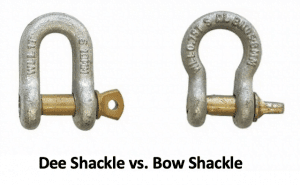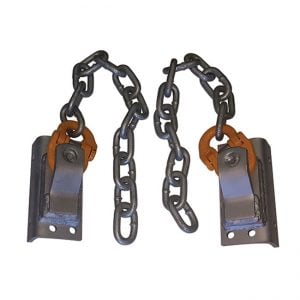Announcement posted by Couplemate Trailer Parts 08 May 2021
Shackles and Safety Chains
There can be a lot of misleading information out there when towing a caravan or trailer safely. One of the key components of safe towing is ensuring your van is secured correctly by safety chains if the worst was to occur. Couplemate discusses some of the critical facts you should know about safety chains on trailers and debunks some of the myths discussed around the campfire about shackles and safety chain connections. Some of the most common questions we get asked about safety chains involve their rating and the ability to extend them.
Below are a few facts and some campfire myths debunked, complete with references to the Australian regulations.
- Dee or Bow shackles must be compatible with a rated chain. Therefore the safety chain must be stamped with a rating. Police or safety inspectors ask you to prove the Dee Shackle is compatible with the safety chain. How do you do that? Make sure you refer to the regulations linked here. Further, all shackles, hammerlocks, and safety chains ratings can be verified with a Certificate of Conformity that should be accessed through the product's manufacturer if required. (CI-119C, Page 2, para 3).
- Each Chain must be sized such that the minimum breaking load exceeds the ATM. (VSB1 Page 27, para 4).
- Every 4 links of the safety chain must be stamped. (CI-119C, Page 1, para 8).
- The Break Load Limit of the shackle must be 1.5 tonnes greater than the ATM. (CI-119C, Page 3).
- The existing unstamped safety chain need not be replaced on older trailers. (CI-119C, Page 3).
One of the most common questions we are asked is, "Can I legally use a hammerlock or another dee shackle to extend my safety chain?"
Hammerlocks can be used to extend the safety chain legally. However, it is important to note that a Dee Shackle cannot be used in this application - only one Dee Shackle per safety chain is allowed.
Another common question is, "What is the difference between a Dee Shackle and a Bow Shackle?"
Dee Shackles and Bow Shackles are very similar in application, and the primary difference is in their shape design, as you can see in the ges . Rated Bow Shackles are accepted to use in place of a Dee Shackle.
It is important to note: Unstamped Bow Shackles, Dee shackles and Hammerlocks are not compatible with Australian standards.
[embed]https://youtu.be/7wOQ3VlEaf8[/embed]
We have also had a few comments questioning the legality of rated safety shackles being a requirement under the law. Please see more information below:
ADR 62/02
14.3.1.3. For trailers over 3.5 tonnes ‘ATM’, the chain must be made from steel of a minimum 800 MPa breaking stress, conform to the mechanical properties of Grade T chain. Specified in Australian Standard AS 2321 - 2001 Short Link Chain for Lifting Purposes and must be of a size such that the minimum breaking load exceeds the ‘ATM’.
The last six words in this clause require Rated or Stamped Dee Shackles. You must be able to prove your chain complies with your rated ATM.
If you need some help to select the correct size dee shackle - read this link.
Safety Chain Attachments for Aluminium Trailers
Safety chain can be legally attached to an aluminium trailer chassis via Couplemate safety chain holders.
The legal requirement is for the chain holder to be welded. The plate holding the safety chain holder is then bolted to the chassis rail.
Previously, the chain was attached via a bolt passing through the chassis rail and safety chain co-jointly.
Truth vs. Myth
You only need one safety chain attachment points for trailers up to 2.5t. Over 2.5t, two safety chains must be used.
Fact: This is true
You need a 'coloured pin,' i.e. yellow or red, rated shackle to comply with various state rules.
Myth: Trailer safety chains must be rated at or above the ATM of the trailer.
Shackles must be marked or stamped with dee shackles that must be rated to the appropriate capacity of the chain.
Both: The chain and shackle must be stamped with a rating. Shackles need not be coloured.
Chains can be welded in any position on the drawbar.
Myth: Drawbar safety chain attachment points should not come into contact with the road surface. When the trailer is disconnected or detached from the vehicle.
Rated Dee Shackles can be used on trailers up to 4.5t.
Myth: Dee Shackles or Bow Shackles are used to attach the safety chain to chain holders. Alternatively, ½ of the chain link can be welded to the trailer chassis up to 3.5t provided the mounting position does not cause the chain to come in contact with the ground when disconnected or detached. Trailers over 3.5t must use chain holders with Grade 80 safety chain attached.
Download the safety chain rules.
Click here to download the Information sheet from the VSB1 Department of Transport Canberra.
Key Points for chain attachment.
- Up to 2.5t trailers and caravans require one rated safety chain that can be welded or fixed to a chassis rail by an approved and rated hammerlock or similar device.
- 2.5t up to 3.5t trailers and caravans must have two safety chains that can be welded or fixed to a chassis rail by an approved and rated hammerlock or similar device.
- 3.5t to 7.2t safety chains must be Grade 80 and attached to the trailer and towbar using a high tensile 4140 pin.
Important notes:
- One safety chain attachment point required on a trailer up to 2.5t - VSB1.
- Two Chains required on a trailer over 2.5t - VSB1.
- Galvanised Chain is illegal over 3.5t.
- The safety chains must be crossed under the tow bar receiver when attached to the tow bar.
- Each chain must be sized such that the minimum breaking load exceeds the ATM.
- The working load is stamped on the chain or shackle. - VsB1.
- Breaking load is the working load x 6. - WA CI119C.
- Drawbar safety chain attachments should not come into contact with the road surface when the trailer is disconnected. - VSB1.
- Chains must be permanently attached to the trailer; shackles are not permitted for trailers over 3.5t. QLD AIS 12(a).
- Rated Shackles approved as tow bar attachments over 3.5t, provided breaking load 1.5 times ATM - WA CI119C.
- Rated Shackles are illegal to be used as attachments on trailers over 3.5t - WA CI119C.
- Stainless Steel Shackles are not permitted - WA CI119C.
- Safety chain attachment points of both the trailer and tow vehicle must be as near as possible to the coupling. QLD AIS 12(a).
- Herc-Alloy 800 is the required chain for all trailers over 3.5t. (usually a coloured chain) QLD AIS 12(a).
Safety Chain attachment points - QLD AIS 12(a)
Each chain attachment point must be capable of withstanding the following minimum forces without incurring either residual deformation that would interfere or degrade the function of the assembly or any breaks, cracks or separation of components:
Longitudinal tension and compression (N) 1.5 x 9.81 x ATM (in kg)
Vertical Tension and compression (N) 0.5 x 9.81 x ATM (in kg)
Furthermore, the tow bar attachment point on trailers under 3.5t is rated at 1/2 the rating of the tow bar. Therefore when upgrading over 3.5t, each attachment point must be upgraded to accommodate the full ATM.
Finally, trailers over 2000kgs are legally required to have a break-away system. Read more information here about important safety switch lanyard alerts.

